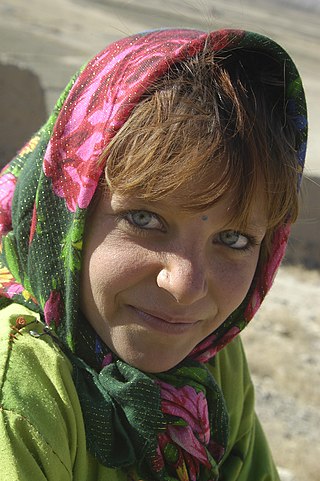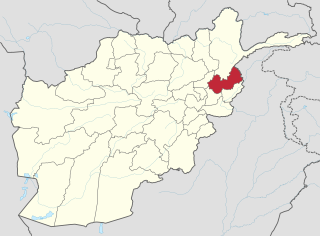
Kāfiristān, or Kāfirstān, is a historical region that covered present-day Nuristan Province in Afghanistan and its surroundings. This historic region lies on, and mainly comprises, the basins of the rivers Alingar, Pech (Kamah), Landai Sin river and Kunar, and the intervening mountain ranges. It is bounded by the main range of the Hindu Kush on the north, Pakistan's Chitral District to the east, the Kunar Valley in the south and the Alishang River in the west.

The Nuristanis, formerly known as Kafiristanis, are an ethnic group native to the Nuristan Province of northeastern Afghanistan and Chitral District of northwestern Pakistan. Their languages comprise the Nuristani branch of Indo-Iranian languages.

Nuristan, also spelled as Nurestan or Nooristan, is one of the 34 provinces of Afghanistan, located in the eastern part of the country. It is divided into seven districts and is Afghanistan's least populous province, with a population of around 167,000. Parun serves as the provincial capital. Nuristan is bordered on the south by Laghman and Kunar provinces, on the north by Badakhshan province, on the west by Panjshir province.

The Nuristani languages, also known as Kafiri languages, are one of the three groups within the Indo-Iranian language family, alongside the much larger Indo-Aryan and Iranian groups. They have approximately 130,000 speakers primarily in eastern Afghanistan and a few adjacent valleys in Khyber Pakhtunkhwa's Chitral District, Pakistan. The region inhabited by the Nuristanis is located in the southern Hindu Kush mountains, and is drained by the Alingar River in the west, the Pech River in the center, and the Landai Sin and Kunar rivers in the east. The languages were previously often grouped with Indo-Aryan or Iranian until they were finally classified as forming a third branch in Indo-Iranian.
Âṣkuňu is a language of Afghanistan spoken by the Ashkun people – also known as the Âṣkun, Ashkun, Askina, Saňu, Sainu, Yeshkun, Wamas, or Grâmsaňâ – from the region of the central Pech Valley around Wâmâ and in some eastern tributary valleys of the upper Alingar River in Afghanistan's Nuristan Province. Other major places where the language of Ashkun is spoken are Nuristan Province, Pech Valley in Wama District, eastern side of the Lower Alingar Valley in Nurgaram and Duab districts, Malil wa Mushfa, Titin, Kolatan and Bajagal valleys.

The Kafir harp is a traditional four- or five-stringed arched harp used by the Nuristanis native to the Nuristan Province of northeastern Afghanistan and Lower Chitral District of northwestern Pakistan. It is played during social gatherings, and to accompany epic storytelling or songs of heroic tales.
The Kom or Kam are a Nuristani tribe in Afghanistan and Pakistan.
The Katir are a Nuristani tribe in Afghanistan and Pakistan.

Dameli (دَميلي), also Damia, Damiabaasha or Gidoj, is an Indo-Aryan language of the Dardic subgroup spoken by approximately 5,000 people in the Domel Town, in the Chitral District of Khyber-Pakhtunkhwa province of Pakistan.

Kalasha is an Indo-Aryan language spoken by the Kalash people, in the Chitral District of Khyber Pakhtunkhwa province of Pakistan. There are an estimated 4,100 speakers of Kalasha. It is an endangered language and there is an ongoing language shift to Khowar.

Kamviri is a dialect of the Kamkata-vari language spoken by 5,000 to 10,000 of the Kom people of Afghanistan and Pakistan. There are slight dialectal differences of the Kamviri speakers of Pakistan. The most used alternative names are Kati, Kamozi, Shekhani or Bashgali.
Waigali, also known as Nuristani Kalasha, is a language spoken by about 10,000 Nuristani people of the Waigal Valley in the Nuristan Province of Afghanistan. The native name is Kalaṣa-alâ 'Kalasha-language'. "Waigali" refers to the dialect of the Väy people of the upper part of the Waigal Valley, centered on the town of Waigal, which is distinct from the dialect of the Čima-Nišei people who inhabit the lower valley. The word 'Kalasha' is the native ethnonym for all the speakers of the southern Nuristani languages.
Kata-vari (Kâta-vari) is a dialect of the Kamkata-vari language spoken by the Kata in parts of Afghanistan and Pakistan. The most used alternative names are Kati, Kativiri or Bashgali.
Wasi-wari is the language of the Wasi people, spoken in a few villages in the Pârun Valley in Afghanistan. It also goes by the name Prasun or Paruni.

Kamkata-vari is the largest Nuristani language. It contains the main dialects Kata-vari, Kamviri and Mumviri. Kata-vari and Kamviri are sometimes erroneously reckoned as two separate languages, but according to linguist Richard Strand they form one language.

Afghanistan is a multiethnic and mostly tribal society. The population of the country consists of numerous ethnolinguistic groups: mainly the Pashtun, Tajik (~25%), Hazara (~10%) and Uzbek people (~10%), and minorities of Aimaq, Turkmen, Baloch, Pashai, Nuristani, Kurds, Gujjar, Arab, Brahui, Qizilbash, Pamiri, Kyrgyz, Sadat and others (~5%). Altogether they make up the Afghan people.
M. Nazif Shahrani is a professor of anthropology, Central Asian Studies, and Middle Eastern Studies at Indiana University, Bloomington.

The Kalasha, or Kalash, are an Indo-Aryan indigenous people residing in the Chitral District of Khyber-Pakhtunkhwa province of Pakistan.
Mawlawi Mohammad Afzal was a Panjpiri-educated Afghan clergyman of the Kam tribe from Barg-i-Matal, Nuristan Province. He studied in Deoband, and later at Akora, Pakistan, before teaching at a madrassa in Karachi, and then in his native village of Badmuk.
Schuyler Jones CBE is an American anthropologist and museum curator. He is best known for his ethnographic fieldwork in the Nuristan region of Afghanistan, as well as his role as Director of the Pitt Rivers Museum, University of Oxford, between 1985 and 1997. Jones is an Emeritus Fellow of Linacre College, Oxford.










